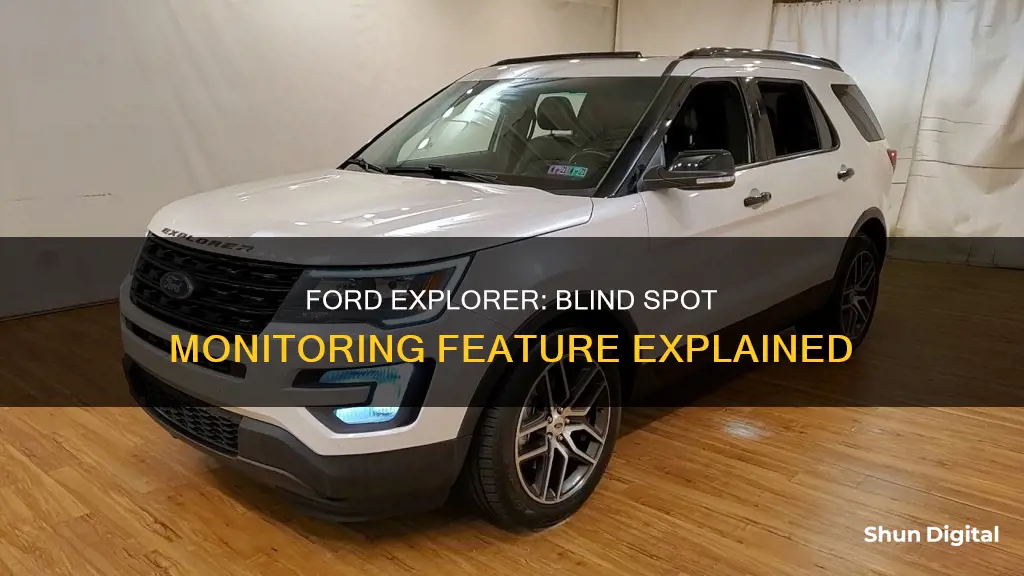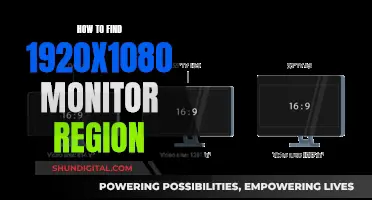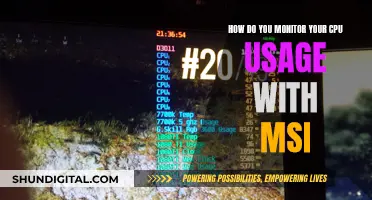
The Ford Explorer is a popular SUV model that offers a range of features, including advanced driver-assistance systems such as blind spot monitoring. The blind spot monitoring feature, known as BLIS® (Blind Spot Information System), is designed to alert drivers to vehicles in their blind spots, which can be difficult to see using mirrors alone. This system uses radar sensors on both sides near the rear of the vehicle to detect objects in the driver's blind spot and alerts the driver through an indicator light in the side-view mirror.
The inclusion of blind spot monitoring in the Ford Explorer varies by model year. While some older models from 2011 to 2019 did not initially come with blind spot monitoring as a standard feature, it was offered as an optional upgrade. Starting with the 2022 model year, Ford made its Co-Pilot360 suite of driver assistance technologies standard on the Explorer, which includes BLIS® with Cross-Traffic Alert. This system not only alerts drivers about vehicles in their blind spots but also provides warnings when backing out of parking spots or driveways, making it a valuable safety feature for drivers.
| Characteristics | Values |
|---|---|
| Blind Spot Monitoring | Available in 2020, 2022, and 2025 models |
| Not available in 2011 models | |
| Known as BLIS® (Blind Spot Information System) | |
| Uses radar sensors on both sides near the rear of the vehicle | |
| Alerts the driver with an indicator light in the side-view mirror | |
| Can be bundled with Cross-Traffic Alert | |
| May not function in snowy, rainy, or icy conditions |
What You'll Learn

Ford's Co-Pilot360 suite of driver assistance technologies
Ford Co-Pilot360 is a suite of driver-assist features that can help you drive more safely. The system includes:
Pre-Collision Assist with Automatic Emergency Braking
This feature scans the road ahead and can alert you to potential collisions with vehicles or pedestrians. If an impact is imminent and you don't take corrective action, the system can automatically apply the brakes to help minimize a frontal collision.
BLIS® (Blind Spot Information System) with Cross-Traffic Alert
BLIS uses radar sensors on both sides near the rear of the vehicle to detect vehicles in your blind spot and alert you with an indicator light in the side-view mirror. The Cross-Traffic Alert feature uses the same radar to detect traffic when you're backing out of a parking spot or driveway and provides visual and audible warnings.
Lane-Keeping System
The Lane-Keeping System scans your vehicle's position between the lines on the road and can alert you if you start to edge out of your lane. If you're drifting out of your lane repeatedly, you'll see a coffee cup icon, letting you know it's time to take a break. The system also provides steering torque to help steer your vehicle back towards the center of the lane.
Auto High-Beam Headlamps
Auto High-Beam Headlamps can sense oncoming headlights and dim automatically, so you can maintain visibility without worrying about blinding other drivers.
Adaptive Cruise Control
Adaptive Cruise Control includes several features to enhance your driving experience:
- Speed Sign Recognition: Detects and automatically adjusts to speed limit signs.
- Stop-and-Go: Slows and stops your vehicle in heavy traffic and resumes your set speed when traffic moves again.
- Lane Centering: Scans lane markings to help keep your vehicle centered.
Evasive Steering Assist
Evasive Steering Assist can alert you to a slow or stopped vehicle in your path and provide extra steering support to help you avoid a potential collision.
Post-Collision Braking
Ford also offers premium driver-assist technologies, including Post-collision Braking, which can help prevent further damage or injury after an initial collision.
Best Monitors to Pair with the Inspiron 5675
You may want to see also

BLIS (Blind Spot Information System)
The Ford Explorer features BLIS (Blind Spot Information System), which uses radar sensors on both sides near the rear of the vehicle to detect objects in the driver's blind spot. When an object is detected, the driver is alerted with an indicator light in the side-view mirror. This system is particularly useful when driving on busy highways or in tight spaces, such as when backing out of a parking spot or driveway.
BLIS is part of Ford's Co-Pilot360 suite of driver assistance technologies, which also includes automatic emergency brakes and lane-keep assist. The Cross-Traffic Alert feature uses the same radar as BLIS to detect traffic when the vehicle is in reverse. When a vehicle is approaching from either side, the system flashes an indicator light in the side-view mirrors and emits an audible warning. Additionally, a visual display in the message centre indicates the direction from which the vehicle is coming.
The 2022 Ford Explorer introduced standard blind spot monitoring with cross-traffic alert, a significant improvement over the previous generation. The system can be turned off using the left-hand menu in the dash, although it defaults to "on" each time the vehicle is started. While some drivers find the system invaluable, others find it distracting, especially when driving at night or on narrow country roads where false alerts are common.
The blind spot assistance feature can turn off due to various reasons, such as sensor malfunction or snow, rain, or ice covering the sensors. In such cases, it is recommended to check the battery and fuses, scan for trouble codes, and reset the computers.
Ideal Monitor Size for Your Arcade Cabinet
You may want to see also

Cross-Traffic Alert
The Ford Explorer comes with a Blind Spot Information System (BLIS) that uses radar sensors on both sides near the rear of the vehicle to detect objects in the driver's blind spot. When something is detected, the driver is alerted with an indicator light in the side-view mirror.
The Cross-Traffic Alert feature uses the same radar technology to detect traffic when the vehicle is slowly reversing out of a parking spot or driveway. When a vehicle is approaching from either side, the system emits an audible warning and flashes an indicator light in the side-view mirrors. A visual display in the message centre also indicates the direction from which the vehicle is coming.
The 2022 Ford Explorer comes standard with Ford's Co-Pilot360 suite of driver assistance technologies, which includes BLIS with Cross-Traffic Alert. This is a significant improvement over the previous generation, which did not offer blind spot monitoring.
Differentiating CRT and LCD Monitors: A Quick Guide
You may want to see also

Adaptive Cruise Control
The Ford Explorer comes with a variety of driver-assistance features, including Adaptive Cruise Control. This optional safety feature automatically adjusts your speed to maintain a safe distance from the vehicle in front of you.
Benefits of Adaptive Cruise Control:
- Enhanced Safety: By automatically adjusting your speed, ACC helps you maintain a safe distance from the vehicle ahead, reducing the risk of a rear-end collision.
- Reduced Fatigue: ACC can help reduce driver fatigue, especially on long trips or in stop-and-go traffic, as you don't need to constantly monitor and adjust your speed.
- Improved Traffic Flow: With ACC, your vehicle automatically adjusts to the flow of traffic, helping to improve overall traffic flow and reduce the risk of sudden stops.
How to Use Adaptive Cruise Control in the Ford Explorer:
While specific steps may vary depending on the model year and configuration, here are the general steps to activate and use ACC in the Ford Explorer:
- Ensure the vehicle is in drive (D) and you are on a suitable road (highway or open road).
- Press the "Adaptive Cruise Control" button, usually located on the steering wheel or nearby control panel.
- Set your desired speed using the accelerator or the "+" and "-" buttons on the steering wheel.
- The system will now maintain this speed until you manually adjust it or deactivate ACC.
- If a vehicle ahead of you is detected, the system will automatically adjust your speed to maintain a safe distance.
- You can adjust the following distance using the "Distance" settings, typically found on the steering wheel or control panel.
- To deactivate ACC, press the "Cancel" or "Off" button, or tap the brakes.
Limitations and Considerations:
While ACC is a valuable safety feature, it is important to remember that it does not replace the need for safe driving practices:
- Always pay attention to the road and be prepared to take over at any time.
- ACC may not detect all objects or vehicles, especially in adverse weather conditions or on curved roads.
- Maintain a safe following distance and stay alert, as the system may not react to sudden stops or unexpected obstacles.
- Review the Ford Explorer owner's manual for specific instructions, limitations, and considerations regarding ACC.
Customer Perspectives on the Ford Explorer's Blind Spot Monitoring:
The Ford Explorer's Blind Spot Information System (BLIS) has received mixed reviews from customers. Some appreciate the added safety and convenience, especially in heavy traffic or on highways. The system uses radar sensors and sideview mirror indicators to alert drivers about vehicles in their blind spots. The Cross-Traffic Alert feature is particularly useful when backing out of parking spots or driveways, providing both visual and audible warnings.
However, some customers have reported challenges with false indications, especially in areas with narrow, winding roads or when driving past certain structures like fences or mailboxes. The system can also be distracting at night due to frequent alerts. Some drivers prefer to rely on standard convex mirrors or use BLIS in conjunction with additional convex mirrors for a more comprehensive view.
In conclusion, while the Ford Explorer's Adaptive Cruise Control and Blind Spot Monitoring features offer enhanced safety and convenience, it is important to understand their limitations and remain vigilant while driving.
Simple Ways to Check Your Monitor's Hz
You may want to see also

Radar sensors
The radar sensors are also utilised by the Cross-Traffic Alert feature. This feature assists drivers when backing out of parking spots or driveways by detecting traffic approaching from either side. In addition to the visual indicator light in the side-view mirrors, the Cross-Traffic Alert also emits an audible warning and provides a visual display in the message centre, indicating the direction from which the vehicle is approaching.
The radar sensors for the BLIS and Cross-Traffic Alert systems are available as OEM parts for the Ford Explorer, ensuring that drivers can benefit from this advanced technology. These sensors are located behind the rear bumper and can be programmed using specialised software and tools, such as FORScan.
While the radar sensors provide valuable assistance, it is important to note that they may be affected by certain conditions. For example, the system may shut off if the sensors are covered by snow, rain, or ice, as mentioned in a discussion about a 2020 Ford Explorer. Additionally, some drivers have reported false indications on narrow country roads, where the system detects stationary objects like fences, mailbox rows, or piles of snow as vehicles in the blind spot.
Resetting Your ASUS Monitor's Colors: A Step-by-Step Guide
You may want to see also
Frequently asked questions
Yes, the Ford Explorer has a Blind Spot Information System (BLIS) that alerts you to vehicles in your blind spot.
The system uses radar sensors on both sides near the rear of the vehicle. When a vehicle is detected in your blind spot, you are alerted with an indicator light in the side-view mirror.
The system also has a Cross-Traffic Alert feature that uses radar to detect traffic when you're backing out of a parking spot or driveway. It flashes an indicator light in the side-view mirrors and emits an audible warning.
No, blind spot monitoring is only available on certain trim levels and model years of the Ford Explorer. It may be optional on some models.







